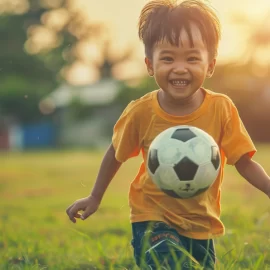
This is a free excerpt from one of Shortform’s Articles. We give you all the important information you need to know about current events and more.
Don't miss out on the whole story. Sign up for a free trial here .
Want to know how to help children with anxiety? What does the research say? What should parents know?
Children today are being bombarded with worries that preceding generations didn’t face. While anxiety disorders in children and teens have been on the rise for 15 years, the Covid-19 pandemic disruption exacerbated an already alarming situation.
Keep reading for five things to do if you want to help children cope with an anxiety disorder.
How to Help Children With Anxiety
It’s natural, even good, for kids to be exposed to the normal stress that comes from day-to-day challenges like a big exam or a fight with a friend. Overcoming such difficulties builds their resilience and gives them the skills they need to grow into independent adults. However, this generation may simply be dealing with too much—a unique combination of unrelenting stressors, unlimited internet access, and earlier puberty that has had a profound effect on their psychological well-being. Additionally, research suggests there was at least a 20% increase in kids exhibiting depression and anxiety symptoms in the first year of the pandemic. This situation has left many parents and adults wondering how to help children with anxiety disorders.
Research shows that the best treatment for anxiety in children is cognitive behavioral therapy (CBT), an approach that emphasizes changing unhealthy patterns of thinking. However, many may not have access to professional care. For example, in the US, only 30% of counties offer psychiatric services specifically for children and adolescents. In places where help is available, the wait for an appointment may take months, or it may be too costly.
To help children with anxiety and other mental health disorders, experts stress the need for systemic and regulatory changes such as increasing federal funding for mental health care for children, improving access to telemedicine, establishing prevention programs in schools and communities, and addressing income inequality to give more people access to care. But waiting for these changes can take years.
Absent access to professionals, here are five ways you can help children with anxiety disorders.
#1: Recognize That Their Struggle Is Real
Older generations might dismiss young people as “snowflakes,” or as too sensitive and lacking resilience, but if you want to know how to best help children with anxiety, then it’s important to approach them with empathy and openness. Try to understand the unique challenges facing today’s kids. Experts advise talking to them with compassion and asking questions about what’s on their mind, how they’ve been sleeping, or what made them feel good that day. If teenagers are reticent, try taking up a hobby with them to help them get more comfortable and encourage them to open up.
#2: Look for Resources
You can help your child and yourself get a better grasp of what they’re going through by reading books about anxiety in children and teens. You can also look for support groups or online resources that equip parents, teachers, school nurses, and others with science-based tools and skills to address anxiety in young people. These expert-led resources train caregivers to provide preventative care, recognize early warning signs, and help manage mental health issues. There are even internet-delivered CBT programs and free apps that have been found to be effective.
#3: Encourage Them to Take Action
For helping children who have specific anxiety issues, such as eco-anxiety, answer their questions honestly, adapting your conversations to their age. While it doesn’t help to sugarcoat, it does help to communicate a sense of optimism: Tell young kids about the good work that scientists, businesses, and governments are doing to address the issue, and encourage older kids to be proactive. This can take the form of protests, awareness campaigns, or political engagement. They might also consider a future career that allows them to contribute to solving the problem.
#4: Cover the Basics
Establishing healthy habits (getting enough sleep, eating a balanced diet, and engaging in physical activity) can go a long way toward improving their mental health. Children need structure, so experts recommend implementing a predictable routine with consistent mealtimes and bedtimes as a way to help children cope with their anxiety.
Limiting screen time may be a challenge, but at least keep gadgets out of their bedroom after lights out; research suggests that screen time before bed—or even having a phone beside them while they sleep—increases the risk of insufficient or poor-quality sleep. You can also encourage them to participate in extracurricular activities like sports and community service to further reduce gadget time, with the added bonus of giving them a sense of purpose that can boost their self-esteem.
#5: Reflect on Your Own Behavior and Parenting Style
Kids take their cues from your behavior, so consider whether you’re getting too much screen time. Put gadgets away and focus on your kids when you’re talking, and institute tech-free family dinners.
Additionally, to help children with anxiety, it’s important to reflect on whether you’re overly anxious. Your behavior may inadvertently be aggravating your child’s worries—research suggests that anxiety can be contagious, most easily transmittable from parent to child. Helicopter parenting, being overly accommodating, or being overprotective can make them more anxious in the short term and may be detrimental in the long term. While it’s important to keep them safe, practice empathy, and understand their challenges, it’s just as important to let them face struggles head on.
| If you’re concerned that your child may be having thoughts of suicide: – US residents: Call the Suicide and Crisis Lifeline at 988, dial 911, take them to the emergency room, or find additional resources here. – Outside the US: Find a list of resources here. |

Want to fast-track your learning? With Shortform, you’ll gain insights you won't find anywhere else .
Here's what you’ll get when you sign up for Shortform :
- Complicated ideas explained in simple and concise ways
- Smart analysis that connects what you’re reading to other key concepts
- Writing with zero fluff because we know how important your time is






